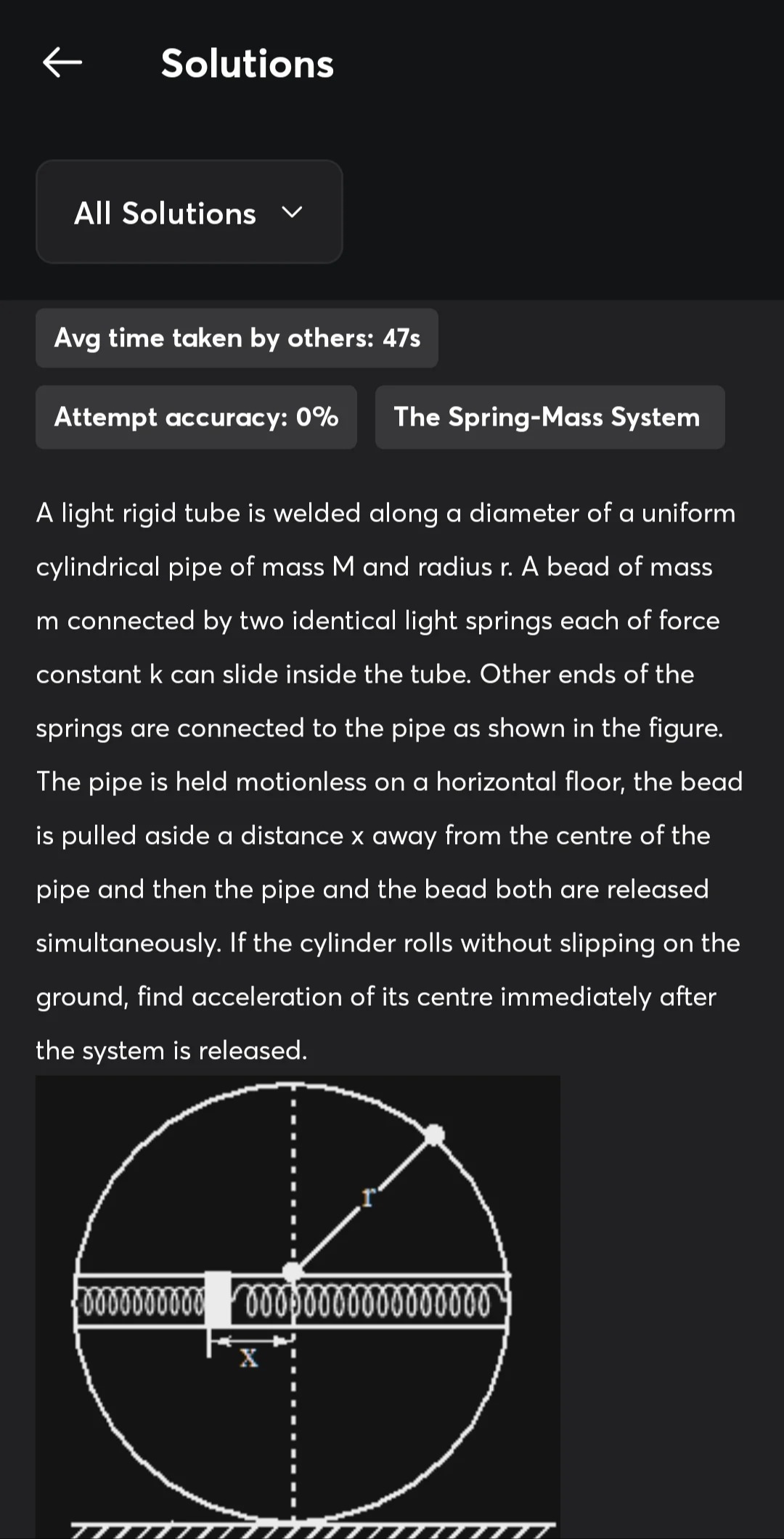Question
Question: The Spring-Mass System A light rigid tube is welded along a diameter of a uniform cylindrical pipe o...
The Spring-Mass System A light rigid tube is welded along a diameter of a uniform cylindrical pipe of mass M and radius r. A bead of mass m connected by two identical light springs each of force constant k can slide inside the tube. Other ends of the springs are connected to the pipe as shown in the figure. The pipe is held motionless on a horizontal floor, the bead is pulled aside a distance x away from the centre of the pipe and then the pipe and the bead both are released simultaneously. If the cylinder rolls without slipping on the ground, find acceleration of its centre immediately after the system is released.

a_c = 4kx/(3M)
Solution
Solution Explanation
We choose as generalized coordinates the cylinder’s rotation angle θ and the bead’s displacement δ relative to the cylinder. With the rolling‐without‐slipping condition, the centre’s displacement is X = rθ so that its acceleration is a_c = rθ̈.
- The cylinder has translational kinetic energy ½ M (rθ̇)² and rotational kinetic energy ½ I θ̇² (with I = ½ M r² for a uniform cylinder).
- The bead (mass m) moving relative to the ground has velocity (rθ̇ + δ̇), so its kinetic energy is ½ m (rθ̇ + δ̇)².
- The springs (two identical ones, natural length chosen so that δ = 0 is equilibrium) together give potential energy kδ².
Thus the Lagrangian is L = ½ M r² θ̇² + ½ I θ̇² + ½ m (rθ̇+ δ̇)² – kδ².
The Euler–Lagrange equations give (after linearization about δ(0)=x, δ̇(0)=0, θ̇(0)=0):
-
For δ (bead’s coordinate): m (rθ̈ + δ̈) + 2kδ = 0 [Since the total spring force on the bead is –2kδ, with δ = x initially.]
-
For θ (cylinder’s rotation): (M r²+ I) θ̈ + m r (rθ̈+ δ̈) = 0.
Substitute I = ½ M r². Then (M r²+ ½ M r²) = (3/2)M r² so that the rotation eqn becomes ((3/2)M r²)+ m r²)θ̈ + m r δ̈ = 0.
Using the bead eqn, express δ̈ as δ̈ = – (2kδ)/m – rθ̈. At t = 0, δ = x. Substitute into the cylinder eqn: [(3/2 M + m)r²]θ̈ + m r [ –(2kx)/m – rθ̈] = 0, which simplifies to ((3/2)M r² – m r² θ̈ + [–2kx·r]) [θ̈] … More carefully, grouping the θ̈–terms we find: ((3/2)M r² + m r² – m r²)θ̈ = 2kxr [after rearrangement]. Thus, (3/2) M r² θ̈ = 2kxr ⇒ θ̈ = (2kx r)/( (3/2)M r² ) = (4kx)/(3Mr).
So the centre’s acceleration is a_c = rθ̈ = r ⋅ (4kx/(3Mr)) = 4kx/(3M).
Answer
The acceleration of the centre of the cylindrical pipe immediately after release is
ac=3M4kx.
